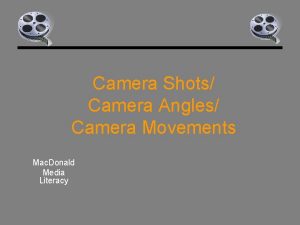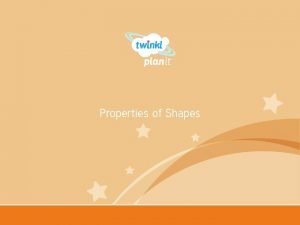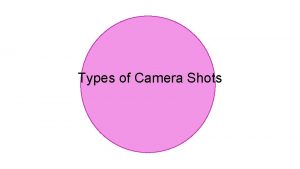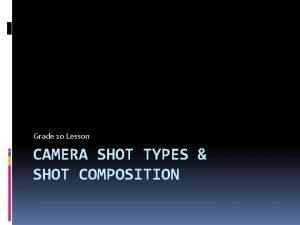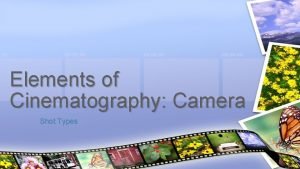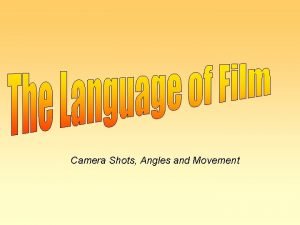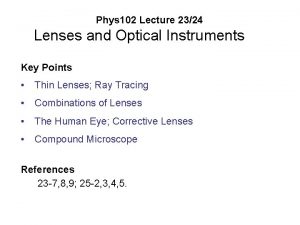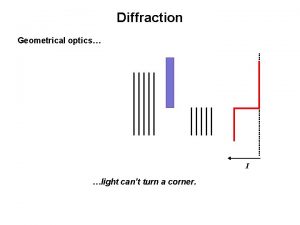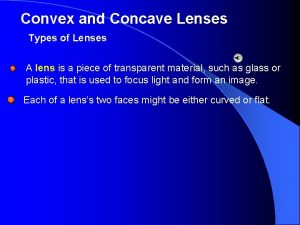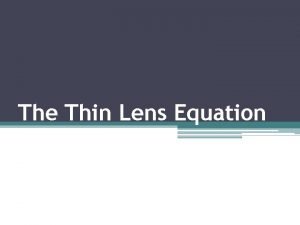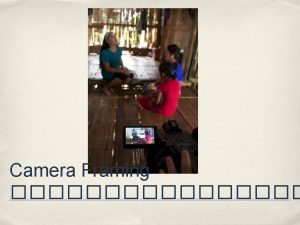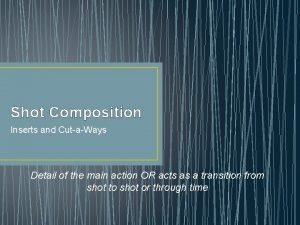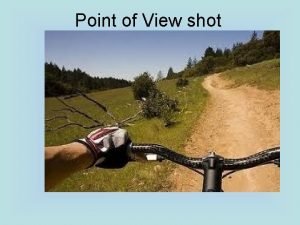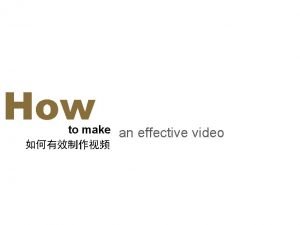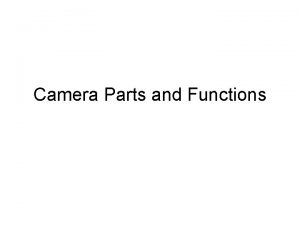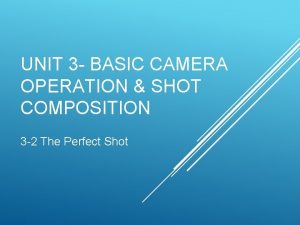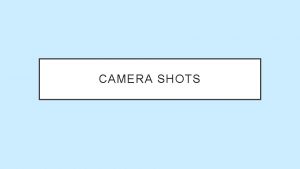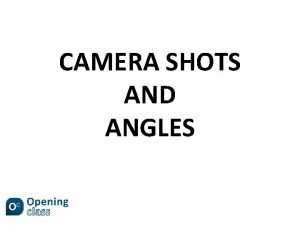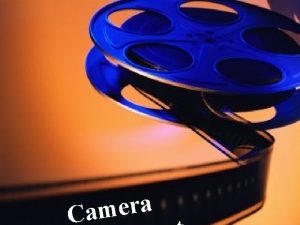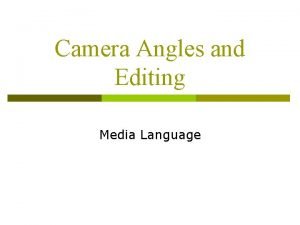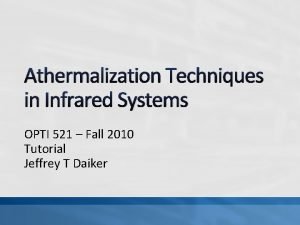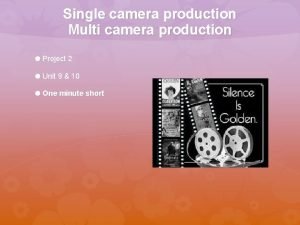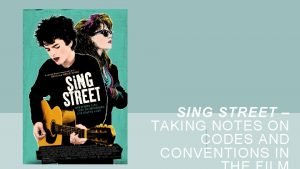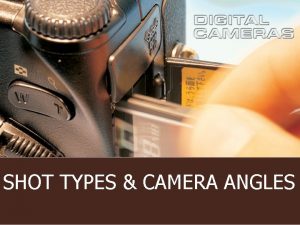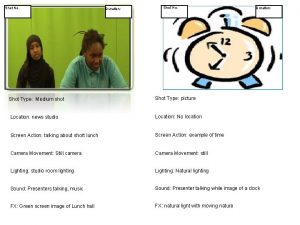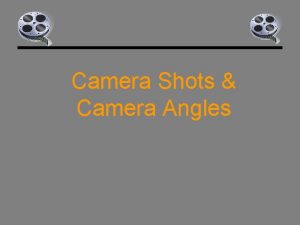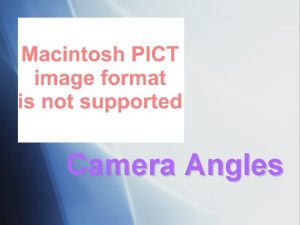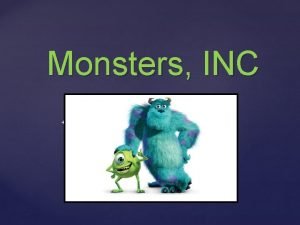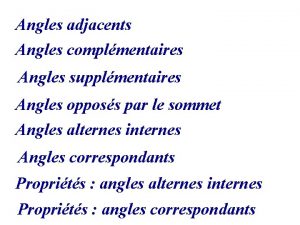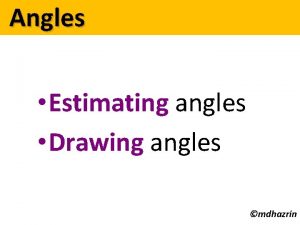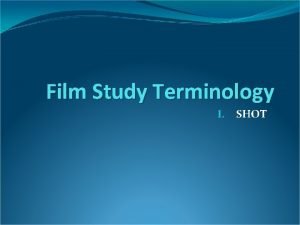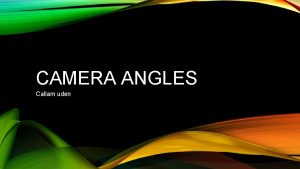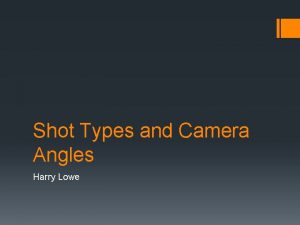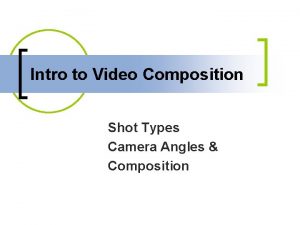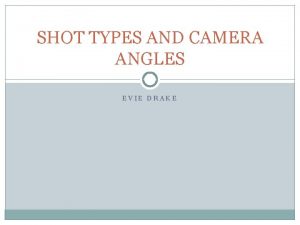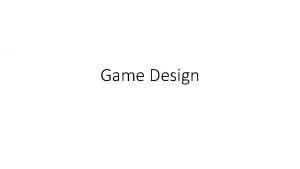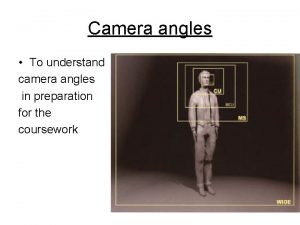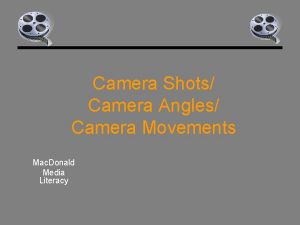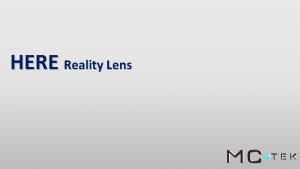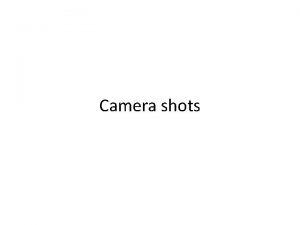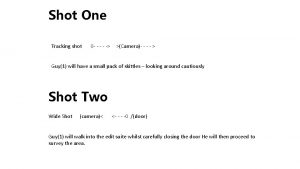Shot Types Camera Angles Focus Lens Techniques Camera


































- Slides: 34

• Shot Types • Camera Angles • Focus • Lens Techniques • Camera Movement Camerawork

Shot Types

Extreme Long-Shot (XLS) Wide Shot Establishing Shot • AKA full or wide shot or establishing shot • Shows entire subject (person or object) from a distance • Intended to highlight setting or place subject in its surroundings • Usually used as an establishing shot to locate the action

Long-Shot (LS) • Can also be referred to as a wide shot • Shows entire subject (person or object) but closer than an XLS • Intended to place subject in its surroundings

Medium Long Shot (MLS) • Between long shot and medium shot • Depicts a person from around the ankles upwards • Allows a lot of the environment to be seen • Several people can be observed

Medium Shot (MS) • Shot from medium distance • Depicts characters from around the waist upwards • Allows viewers to focus on characters’ expressions and movements • Still shows a reasonable amount of the environment

Medium Close-up (MCU) • Between a medium shot and a close-up • Humans are generally framed from mid-torso upwards • Can observe facial expressions clearly without being too close

Close-up (CU) • Tightly frames the subject • Close-ups of people will generally be head and shoulders • Can be other part of the human body • Used to highlight emotion or intricate activity • Partially eliminates the broader scene

Big Close-up (BCU) • Similar to a close-up but without the shoulders and top of the head • Used when facial expressions and emotions are important • Almost entirely eliminates the broader scene

Extreme Close-up (XCU) • So close that only a very small part of the subject is visible • Generally too close to display emotions or reactions

Point of View (POV) • When we the audience see exactly what he character is seeing. This puts the audience in a subjective position

Over the Shoulder (OTS) • The camera is positioned over the shoulder of a character in the scene • This shot is often used in dialogue shots so that we can see both characters but can focus on the face of one of them. Sometimes we feel as if we are in the scene with the characters.

Camera Angles

Eye Level • The camera is positioned as if a human were observing a scene • Actors' heads are on a level with the focus • The camera is about five to six feet from the ground

Ground Level • The camera is positioned very close to the ground • The camera is level with the focus

High Angle/Bird’s Eye • The camera is higher than the action and looks down on it • High angles make characters seem less significant or powerful • Objects and character get swallowed up by their environments • Often used when characters are in danger or vulnerable

Aerial Shot • Shows action from directly overhead • Puts the audience/viewer in godlike position • May render familiar objects totally unrecognisable at first • Can make characters look insignificant and ant-like

Low Angle/Worm’s Eye • The camera is lower than the action and looks up to it • Low angles make characters seem larger and more powerful • Characters can appear intimidating and threatening • They can make the audience feel vulnerable

Extreme Low Angle • Often removes background and context • The lack of setting can cause disorientation for the viewer • Can give a sense of confusion and vulnerability to viewers

Oblique Angle • AKA canted, expressionistic or Dutch angle • Suggests disorientation and a world out of balance • Externalises (ie makes visible) characters’ sense of unease • Makes the audience feel uneasy

Focus

Shallow Focus • Uses a small depth of field (Do. F) • Only one plane of the image is in focus • Used to emphasize one part of the image • Focus can move during a shot to highlight a different part of image

Deep Focus • Uses a large depth of field (Do. F) • Foreground, middle-ground and background are all in focus

Lens Techniques

Zoom In • Elements of the lens are moved to magnify part of a scene • Creates a closer, tighter image • Used to direct a viewer’s attention and focus • The camera may not actually move

Zoom Out • Effectively the opposite of a zoom in • Goes from close to wide to reveal more of a scene • Creates a wider image • The camera may not actually move

Camera Movement

Pan • Usually on a tripod or dolly which acts as a stationary axis point • Camera scans a scene horizontally (left to right or right to left) • Can be combined with other movements (such as tracking) • In a ‘whip pan’ this action happens very quickly

Tilt • Similar to a pan but where the camera pivots vertically (up and down)

Tracking • The camera is placed on a moving vehicle (usually a dolly) which moves • The camera can move forwards, backwards or sideways • Can follow subjects or move towards /away from them

Hand-held • The camera is literally hand-held by the operator • The image is shakier than a tripod or dolly mounted shot • Produces a ‘fly-on-the-wall’ effect • Viewers feel part of the scene • The awkward movements can also make viewers feel uneasy

Steadicam • The camera is carried by the operator, similar to hand-held shots • The Steadicam mount makes shots much smoother • Can be used in places where tracks and dollies are impractical

Crane • Produces smooth movements • Can move up, down, left, right, swoop in on action or move away from it • Can go from ground level to extreme high-angles • Also useful for high-angle shots without movement

Aerial • Usually taken from a helicopter • Often used at the beginning of film to establish setting • Like a particularly flexible sort of crane - it can go anywhere • Can convey real drama and exhilaration • Can produce extremely high-angles
 Extreme long shot (els)
Extreme long shot (els) Angles - vertically opposite angles and missing angles
Angles - vertically opposite angles and missing angles Types of shots
Types of shots Shot composition types
Shot composition types What is a mid shot
What is a mid shot Camera shot types
Camera shot types Types of camera angles
Types of camera angles Converging vs diverging lens
Converging vs diverging lens Huygens
Huygens Convex lens vs concave lens
Convex lens vs concave lens Image distance formula
Image distance formula Language
Language Cost focus and differentiation focus
Cost focus and differentiation focus Drivers of differentiation
Drivers of differentiation Actor focus vs object focus
Actor focus vs object focus Ews camera shot
Ews camera shot Example of cutaway shot
Example of cutaway shot Objective shot
Objective shot Dramaturgiske model
Dramaturgiske model Wide shot medium shot close up
Wide shot medium shot close up Camera lens parts and functions
Camera lens parts and functions Shot list template
Shot list template Headroom camera shot
Headroom camera shot Very long shot (vls
Very long shot (vls High angle shot reference
High angle shot reference Very long shot (vls)
Very long shot (vls) Extreme long shot drawing
Extreme long shot drawing Crane camera movement
Crane camera movement Bird's eye view vs worm's eye view
Bird's eye view vs worm's eye view Cutaway camera angle
Cutaway camera angle Undershot camera angle
Undershot camera angle Athermalization techniques lens
Athermalization techniques lens Multi camera production techniques
Multi camera production techniques Camera movement
Camera movement Sing street notes
Sing street notes
